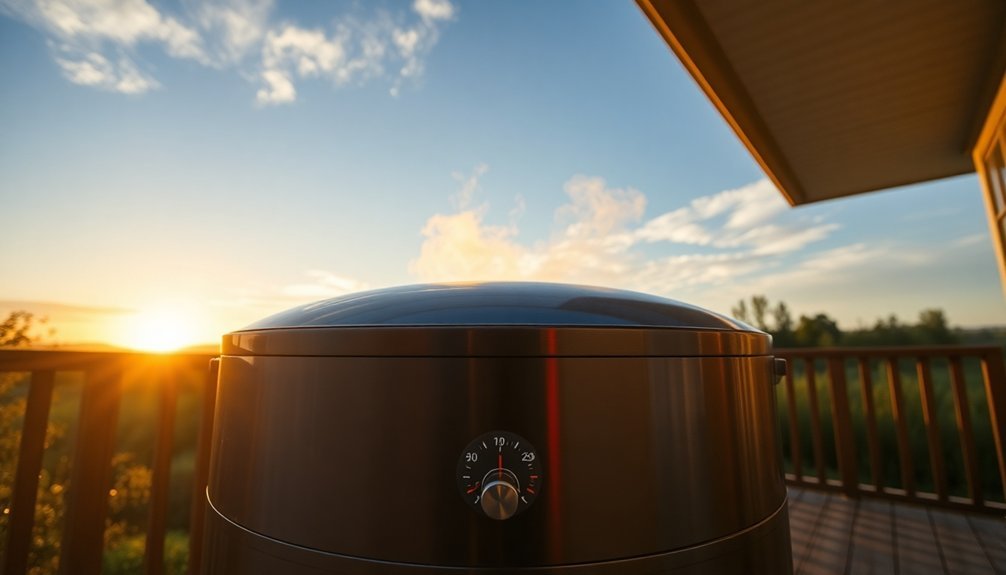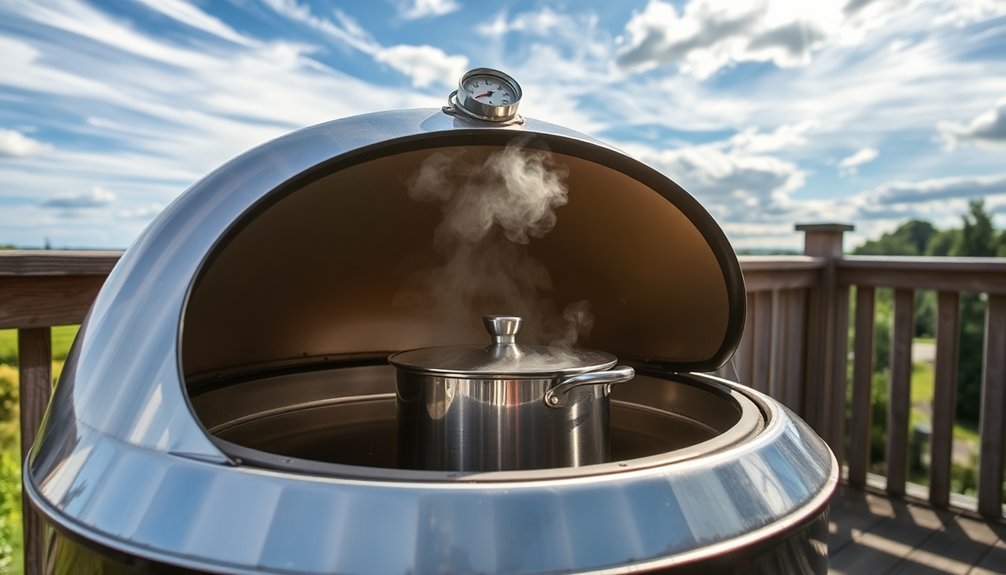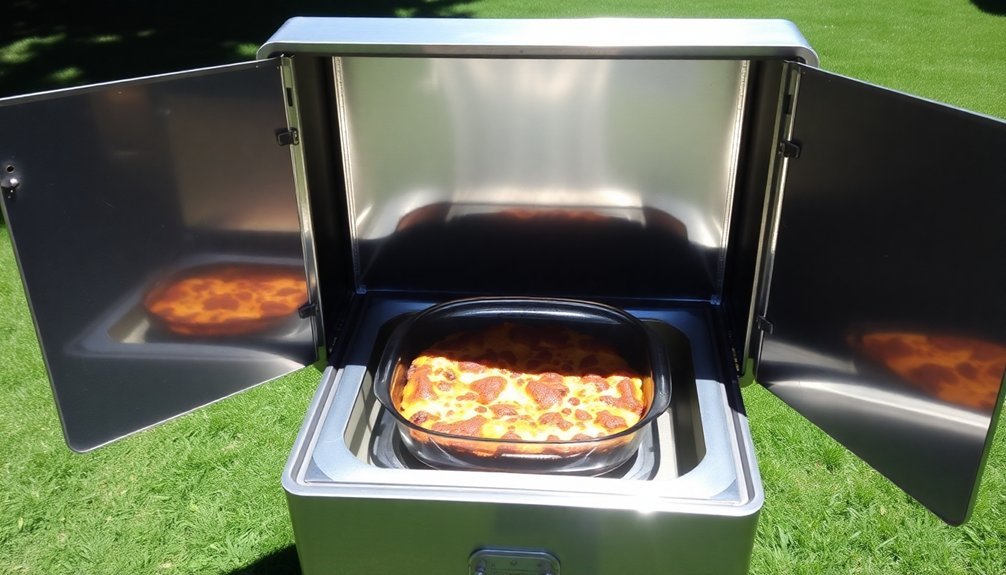Your solar oven needs extra cooking time because it relies on variable sunlight instead of consistent artificial heat. You'll find that cloud cover, sun angle, and seasonal changes affect the oven's temperature, making cooking take 1.5 to 3 times longer than conventional methods. Even on clear days, you'll need to regularly adjust the reflectors to track the sun's movement and maintain ideal heat. The most efficient cooking window is between 11 AM and 3 PM when sun intensity peaks. Factors like food volume, pot selection, and insulation quality can greatly impact your solar cooking success.
Sunlight Position and Cooking Efficiency

When positioning a sun oven for ideal cooking efficiency, the time of day and sun's location play essential roles in performance.
You'll get the best results between 11:00 am and 3:00 pm when the sun is at its peak intensity, especially if you face your oven directly toward the sun at noon.
To maximize your cooking time, position your box's longer east-west dimension to make better use of the reflector throughout the day. Adding high-quality insulation materials helps maintain consistent cooking temperatures even when sunlight varies.
You'll need to adjust the oven's position as the sun moves across the sky, though this isn't as critical if you're cooking near the equator (between 20°N and 20°S).
Using reflectors effectively can boost your cooking temperature considerably – they're particularly important in temperate regions where the sun isn't directly overhead.
Temperature Control Challenges
Controlling temperature in a solar oven presents unique challenges beyond simple sun positioning.
You'll notice significant temperature fluctuations throughout the day as clouds pass and the sun moves. Even with ideal conditions, your solar oven's temperature won't remain constant, requiring frequent monitoring and adjustments. Type-K thermocouples provide essential data for maintaining optimal cooking temperatures.
The type of solar oven you're using greatly impacts temperature control.
Here's what you can expect:
- Parabolic cookers reach up to 700°F but are more sensitive to sun position
- Box ovens maintain steadier temperatures but max out around 400°F
- Panel cookers typically stay under 300°F and need more cooking time
To improve temperature control, you'll need proper insulation using materials like crumpled newspaper or fiberglass.
Multiple layers and secure glazing help trap heat, while reflective surfaces enhance heat concentration and retention.
Weather Impact on Performance

Weather conditions greatly influence your solar oven's performance and efficiency. When clouds block direct sunlight, you'll notice considerably longer cooking times and may need to adjust your cooking schedule.
Even with perfect conditions, solar cooking typically takes 1.5 to 3 times longer than traditional cooking methods.
Wind can disrupt heat retention, so you'll want to place your oven in a sheltered spot.
To combat weather challenges, you'll need proper insulation using materials like feathers, cotton balls, or newspapers to trap thermal energy. Confirm your oven has airtight seals and line the bottom with black construction paper for better heat absorption.
Position reflective surfaces, such as aluminum foil or mirrors, to concentrate solar radiation, especially during peak hours between 11:00 am and 3:00 pm.
During winter months, you'll need to make seasonal adjustments, including positioning your oven in south-facing windows and adding extra insulation.
Seasonal Sun Patterns
Your sun oven's performance will be noticeably affected during winter months when daylight hours shrink and the sun's angle remains low in the sky.
You'll need to plan for longer cooking times during winter, as the limited solar exposure can extend typical recipes by 1-2 hours compared to summer cooking.
During the equinoxes in spring and fall, you can expect moderate adjustments to cooking times as the sun's path and intensity shift between their summer and winter extremes.
Winter's Limited Solar Exposure
Solar cooking during winter months presents unique challenges due to the sun's seasonal patterns and limited exposure times.
You'll find your cooking window markedly reduced to just 4 hours between 10 AM and 2 PM, compared to summer's generous 10-hour span. The sun's lower position and weaker rays mean you'll need to adjust your oven more frequently to capture ideal sunlight.
Winter weather conditions further complicate solar cooking:
- Cloud cover, fog, and high humidity reduce solar efficiency
- Snow and ice require regular cleaning of your oven's surfaces
- Low UV intensity demands enhanced insulation techniques
To maximize winter cooking success, tilt your oven to match the sun's angle, use additional reflective materials, and consider preheating strategies.
While cold temperatures don't directly affect solar cooking, the reduced sunlight intensity means you'll need longer cooking times.
Equinox Cooking Time Changes
During equinoxes, cooking times with your sun oven require careful planning due to the sun's distinctive position and shorter peak hours. You'll need to start cooking earlier in the day since you'll only have about 12 hours of daylight to work with. The sun's lower angle in the sky means you'll need to adjust your oven more frequently to maintain ideal heat.
| Time of Day | Sun Position | Required Action |
|---|---|---|
| Morning | Rising East | Initial Setup |
| Midday | Overhead | Minor Adjustments |
| Afternoon | Western Sky | Major Realignment |
| Evening | Setting West | Final Monitoring |
For best results, reposition your oven every 20-30 minutes to track the sun's movement. You'll likely experience temperatures between 225-300°F, so choose foods that cook well at lower temperatures, like beans, stews, and casseroles.
Reflector Positioning Requirements

You'll need to position your sun oven's reflectors precisely to achieve ideal cooking temperatures by aligning them directly with the sun.
Track the sun's movement using the E-Z Sun-track indicators, ensuring the light dot falls into the bottom hole while adjusting both side-to-side positioning and the rear alignment leg height.
For maximum light concentration, keep the reflectors securely fastened with the thumbscrews and maintain proper seasonal angles, especially during winter months when you might need to lay the oven on its back for better exposure.
Optimal Angle for Reflection
Properly positioning your Sun Oven's reflectors is crucial for maximizing heat and achieving consistent cooking results. You'll need to unfold the reflectors and secure them with the thumbscrew, ensuring there are no shadows on the oven chamber.
For peak performance, adjust the height of the rear leg and tilt the oven until shadows are even on all sides.
- During windy conditions, use wire stakes to secure both the oven and reflectors, maintaining stability up to 35 MPH winds.
- Check and readjust the position periodically as the sun moves across the sky to maintain efficient heat collection.
- In winter months or higher latitudes, you may need to lay the oven on its back with latched reflectors to capture maximum solar energy, which adds extra cooking time in mornings and evenings.
Sun Tracking and Adjustment
Building on ideal angle positioning, successful sun oven cooking requires careful attention to sun tracking and reflector adjustments throughout the day.
You'll need to monitor and adjust your oven's position as the sun moves across the sky to maintain peak cooking temperatures.
Use the E-Z Sun-track indicators on the glass door's bottom corners to guide your alignment.
When you stand behind or to the left of the oven, you should see the round dot of light centered over the bottom hole.
Make adjustments using the wind-resistant alignment leg to eliminate shadows in the cooking chamber.
For stability, especially on windy days, secure your oven with wire stakes.
Don't forget to unfold and secure the reflectors properly, ensuring they're directing maximum solar energy toward the cooking surface throughout the day.
Maximizing Light Concentration
Three key factors determine successful light concentration in a sun oven: reflector positioning, alignment with sunlight, and proper insulation.
You'll need to adjust your reflectors regularly to optimize sunlight collection throughout the day. Proper alignment guarantees maximum heat reaches your food while reducing cooking time.
To maximize light concentration, focus on these critical elements:
- Position reflectors at precise angles to direct sunlight into the cooking chamber
- Maintain even shadows on both sides of the oven to confirm proper alignment
- Use clear glazing materials and proper insulation to trap accumulated heat
Your oven's geometrical design plays an essential role in light concentration.
The height, width, and reflector length must work together to guarantee all reflected rays reach the transparent cover and cooking area effectively.
Heat Distribution and Retention
The success of a solar oven depends heavily on its ability to collect, distribute, and retain heat effectively.
You'll need multiple features working together to achieve ideal cooking temperatures. Your oven should incorporate dark-colored surfaces and cookware to absorb up to 95% of incoming solar radiation, while reflective panels help distribute heat uniformly throughout the cooking chamber.
To maintain consistent temperatures, you'll want proper insulation using materials like rockwool or polystyrene sheets.
Double-glazed panels and airtight seals prevent heat loss through convection and radiation. It's crucial to use high-temperature silicone caulk to seal any gaps in the glazing system.
For the best results, you'll need to periodically reposition your solar oven to face direct sunlight, ensuring even heat distribution throughout the cooking process.
Food Volume Considerations

When you're cooking with a sun oven, larger portions of food will naturally take longer to heat through completely.
The time it takes for heat to distribute evenly throughout your meal depends on factors like the density of ingredients and how you've arranged them in your cooking container.
You'll get the best results by matching your container size to your portion size and cutting ingredients into smaller pieces for faster, more uniform heating.
Larger Portions Heat Slower
Since larger portions of food contain more thermal mass, they naturally take longer to reach safe cooking temperatures in your solar oven. The increased mass acts as a heat sink, slowing down the overall heating process even in ideal sunlight conditions.
When you're cooking larger volumes of food, you'll need to take into account these key factors:
- Your cooking time may extend by several hours compared to smaller portions
- The food's mass will absorb and distribute heat more gradually
- You'll need to plan ahead and start cooking earlier in the day
To maximize efficiency with larger portions, think about splitting your meal into multiple smaller containers instead of using one large pot.
This approach helps achieve more even heating and reduces the time needed to reach safe cooking temperatures, even when preparing substantial amounts of food.
Heat Distribution Takes Time
As solar ovens gradually convert sunlight into usable heat, understanding how that heat distributes throughout your food becomes vital for successful cooking.
You'll need to account for the slow process of heat absorption and distribution, which relies heavily on dark-colored cookware to maximize efficiency.
Unlike conventional ovens, solar cooking depends on external factors that affect heat distribution. You'll notice temperature fluctuations when clouds pass overhead or wind picks up, making it important to choose a protected cooking spot.
To maintain consistent heat distribution, you'll want to rotate your oven to track the sun's movement and use proper insulation materials like crumpled newspaper and black construction paper. A clear cover will help trap heat inside, while well-insulated containers can keep your food warm after cooking's complete.
Container Size Affects Duration
The size of your cooking container and volume of food directly influence your solar cooking duration. When you're cooking larger quantities, you'll need more time to guarantee heat penetrates evenly throughout the food.
For example, whole chickens take longer to cook than cut-up portions, and full casseroles require 2 to 3.5 hours compared to quick-cooking items like omelets.
Consider these key volume-related factors when planning your solar cooking:
- Larger dishes like casseroles and roasts need extended cooking times of up to 3.5 hours
- Smaller portions, such as baked eggs, cook in under an hour
- Double-stacking standard pots won't greatly increase overall cooking time
You'll need to adjust cooking times based on your specific recipe, food volume, and daily weather conditions for ideal results.
Dark Pot Heat Absorption
Dark pots serve as the cornerstone of effective solar cooking by absorbing radiant energy from the sun and converting it into heat.
You'll want to use black metal pans, dark brown glass dishes, or cookware with dark enamel coating to maximize heat absorption. Light-colored vessels won't work as effectively since they don't capture solar energy well.
When you combine dark pots with your sun oven's reflective interior and a transparent cover, you'll create an efficient cooking environment.
The dark surface traps heat while the cover produces a greenhouse effect. For best results, you'll need thin-walled dark vessels, as they transfer heat to your food more quickly than thick ones.
While cast iron pots work well for heat retention, they'll require more time to reach cooking temperature initially.
Solar Tracking Adjustments

Since solar ovens rely on direct sunlight for cooking, maintaining proper alignment with the sun becomes essential for ideal performance.
You'll need to adjust your oven every 30-45 minutes to track the sun's movement across the sky, which can greatly impact your cooking times.
While manual adjustments require rotating and tilting the oven by hand, automated tracking systems can do this work for you using solar panels, motors, and servos.
Here's what you should know about solar tracking:
- Manual adjustments are time-consuming but offer a simpler, less expensive solution
- Automated systems provide consistent alignment without constant monitoring
- Poor tracking can lead to uneven heating and extended cooking times
Your choice between manual or automated tracking will depend on your budget, time availability, and cooking frequency.
Insulation and Heat Loss
Proper insulation plays an essential role in maximizing your sun oven's efficiency and maintaining consistent cooking temperatures.
You'll need to combat three main types of heat loss: conduction through the walls, convection from air leaks, and radiation through the transparent cover.
To minimize these losses, you can use foam insulation, multiple glass panes, and reflective materials like aluminum foil.
Make sure your oven's walls are thick and well-insulated with materials like foam or newspaper. A low-height, triangular design will reduce heat loss through surface area.
You'll also want to shield your oven from wind, as it greatly increases convective heat loss.
Consider using additional covers during cloudy periods or when you're not actively cooking to maintain internal temperatures and improve overall cooking efficiency.
Frequently Asked Questions
Can Solar Ovens Be Used Indoors Near Windows or Skylights?
You can use solar ovens near windows or skylights, but they'll be less effective due to reduced sun intensity through glass. For best results, you'll need large, south-facing windows and direct sunlight.
How Long Can Cooked Food Safely Stay Warm in a Solar Oven?
You can safely keep cooked food warm in your solar oven for up to 2-4 hours, but you'll need to maintain temperatures above 140°F (57°C) to prevent bacterial growth. Monitor temperatures regularly.
What Materials Should Be Avoided When Constructing a Solar Oven?
You'll want to avoid dense materials like metal and cement, poor insulators like untreated cardboard, low solar transmittance plastics, and moisture-permeable materials. These reduce heat retention and cooking efficiency in your solar oven.
Does Altitude Affect Solar Oven Cooking Performance and Time?
Yes, altitude markedly affects your solar oven's performance. You'll experience faster cooking times at higher elevations due to increased solar radiation and clearer skies, though you'll need better insulation to combat colder temperatures.
Can Multiple Solar Ovens Be Connected to Create a Larger Cooking System?
You can't effectively connect multiple solar ovens into one system. While it's technically possible, it's impractical due to design differences, synchronization challenges, and complex engineering requirements. You're better off using separate units.
In Summary
You'll need to plan for longer cooking times with your sun oven due to its dependence on natural elements. Since you're relying on sunlight intensity, weather conditions, and seasonal patterns, cooking times aren't as consistent as conventional ovens. You'll achieve the best results by adjusting reflectors throughout the day, using dark cookware, and accounting for food quantity and external temperatures.





Leave a Reply